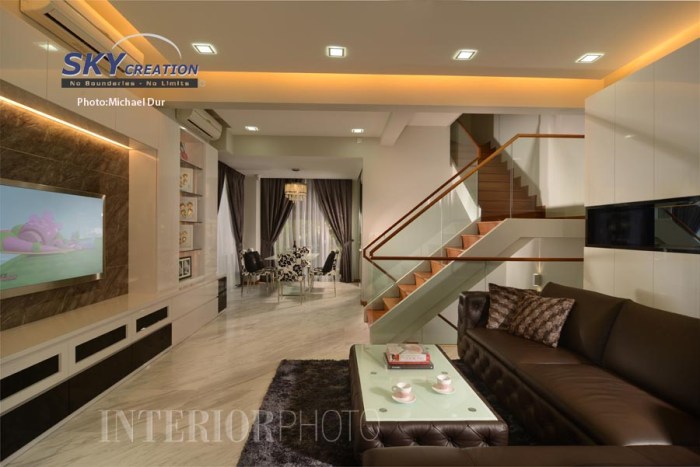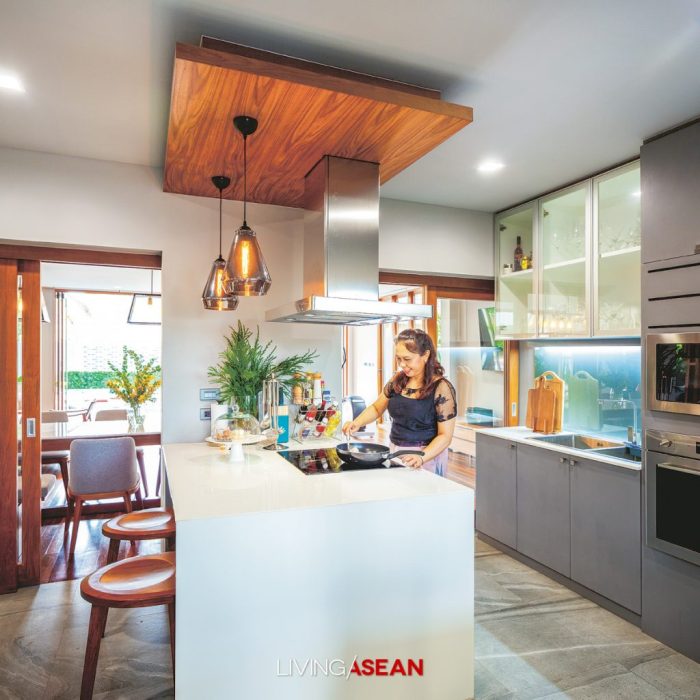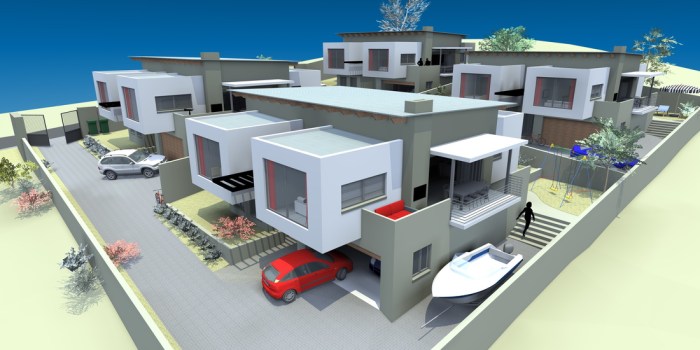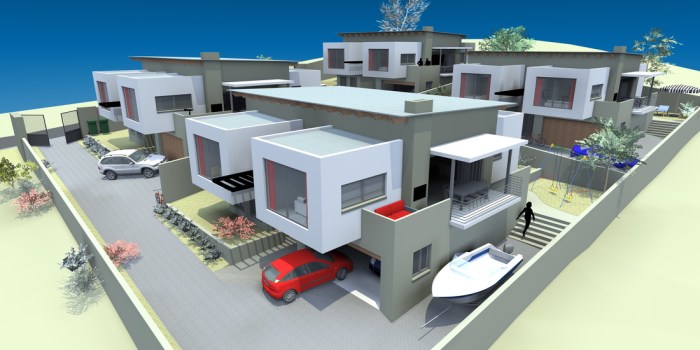Cluster House Interior Design: Creating Harmonious Homes
Cluster house interior design presents a unique challenge: crafting beautiful and functional spaces within the confines of a shared community. This type of housing, with its interconnected units and shared amenities, demands a creative approach that balances individual needs with the desire for a cohesive and welcoming atmosphere.
From optimizing space and maximizing natural light to selecting the right materials and furniture, this guide explores the key considerations for creating stunning and comfortable interiors within a cluster house setting. We’ll delve into the intricacies of layout, lighting, color palettes, and community-building elements, offering practical tips and inspiring ideas to help you transform your cluster house into a sanctuary that reflects your personal style and fosters a sense of belonging.
Lighting and Natural Light: Cluster House Interior Design

Natural light is a powerful design element that significantly influences the ambiance of a cluster house. Its presence can transform a space, making it feel more inviting, spacious, and connected to the outdoors.
Impact of Natural Light on Ambiance
The amount and quality of natural light entering a cluster house have a profound impact on its overall atmosphere.
- Brightness and Warmth:Abundant natural light creates a sense of brightness and warmth, making the space feel more welcoming and energetic. Conversely, limited natural light can lead to a gloomy and oppressive ambiance.
- Spaciousness and Depth:Large windows and skylights allow natural light to penetrate deeper into the space, visually expanding the area and creating a sense of openness and depth.
- Connection to Nature:Natural light brings the outdoors in, connecting the residents to the natural world and fostering a sense of tranquility and well-being.
- Visual Appeal:Natural light enhances the beauty of the interior design, highlighting architectural features, furniture, and artwork. It creates dynamic shadows and patterns that add visual interest.
Designing a Lighting Scheme
A well-designed lighting scheme complements the architecture and enhances the interior of a cluster house, creating a balanced and functional environment.
Cluster house interior design often presents unique challenges, as the layout and shared spaces must be carefully considered. When designing these homes, inspiration can be drawn from the stunning examples of beautiful house interior design in India , which often feature intricate details and vibrant color palettes.
By incorporating these elements, cluster houses can achieve a sense of both individuality and community, fostering a harmonious living environment.
- Maximize Natural Light:Design the house with large windows and skylights to allow ample natural light to penetrate all areas. Consider using light-colored walls and furnishings to reflect light and brighten the space.
- Layer Artificial Lighting:Implement a layered lighting system that incorporates ambient, task, and accent lighting. Ambient lighting provides general illumination, task lighting illuminates specific work areas, and accent lighting highlights specific features.
- Use Warm and Cool Lighting:Warm lighting (yellow tones) creates a cozy and inviting ambiance, while cool lighting (blue tones) promotes focus and concentration. Use a combination of warm and cool lighting to create different moods and highlight specific areas.
- Consider Energy Efficiency:Choose energy-efficient lighting fixtures and bulbs to minimize energy consumption and reduce environmental impact.
Creating Different Moods with Artificial Lighting, Cluster house interior design
Artificial lighting plays a crucial role in setting the mood and atmosphere of a cluster house.
Cluster house interior design offers a unique challenge, maximizing space and functionality within a compact footprint. While the overall design may be limited by the structure, you can still achieve a beautiful and comfortable living space. For inspiration on maximizing space in smaller homes, check out this guide on best small house interior design.
These principles can be adapted to create a welcoming and stylish cluster house interior that truly reflects your personality.
- Relaxing and Intimate:Dimmable lights with warm tones create a relaxing and intimate ambiance, ideal for evenings and social gatherings.
- Energetic and Focused:Bright, cool-toned lighting can create an energetic and focused atmosphere, suitable for workspaces or areas requiring concentration.
- Highlighting Features:Accent lighting can be used to highlight architectural features, artwork, or decorative elements, adding visual interest and depth to the space.
- Creating Visual Drama:Strategic use of light and shadow can create visual drama and emphasize the unique character of the cluster house.
Color Palette and Material Selection
The color palette and material selection for a cluster house interior play a crucial role in creating a cohesive and inviting atmosphere. The choices made in this area can influence the overall mood, style, and functionality of the space.
Color Palette
The color palette should reflect the desired mood and style of the cluster house. For example, a modern cluster house might utilize a neutral palette with pops of vibrant color, while a traditional cluster house might opt for warm and earthy tones.
- Neutral Palettes:These palettes are versatile and can be used to create a sense of calm and sophistication. Examples include white, gray, beige, and black. These colors can be used as a backdrop for bolder accent colors or patterns.
- Warm Palettes:These palettes are known for their inviting and cozy feel. Examples include shades of red, orange, yellow, and brown. These colors can be used to create a sense of warmth and intimacy in a cluster house.
- Cool Palettes:These palettes are often associated with feelings of peace and tranquility. Examples include shades of blue, green, and purple. These colors can be used to create a sense of spaciousness and serenity in a cluster house.
Material Selection
The materials used for walls, floors, and furniture can also contribute to the overall style and atmosphere of a cluster house. Different materials have unique properties that can affect the look, feel, and functionality of a space.
- Walls:Common wall materials include paint, wallpaper, and stone. Paint is a versatile option that allows for a wide range of colors and finishes. Wallpaper can add texture and pattern to walls, while stone can create a more rustic or elegant look.
- Floors:Flooring options for cluster houses include hardwood, tile, and carpet. Hardwood floors are durable and classic, while tile is a good choice for high-traffic areas. Carpet can add warmth and comfort to a space.
- Furniture:Furniture materials can range from wood and metal to fabric and leather. Wood furniture is durable and timeless, while metal furniture can add a modern or industrial touch. Fabric and leather furniture can add comfort and style to a space.
Color and Material Combinations
Here is a table showcasing various color and material combinations for different cluster house styles:
| Style | Color Palette | Wall Material | Floor Material | Furniture Material |
|---|---|---|---|---|
| Modern | Neutral with pops of color | Painted white or gray | Hardwood or tile | Metal or wood |
| Traditional | Warm and earthy tones | Painted beige or brown | Hardwood | Wood or upholstered fabric |
| Contemporary | Cool and calming colors | Painted light blue or green | Tile or concrete | Metal or leather |
| Rustic | Warm and natural colors | Stone or wood paneling | Hardwood or tile | Wood or leather |
Creating a Sense of Community
In the realm of cluster houses, fostering a sense of community among residents is paramount. This goes beyond mere proximity and aims to cultivate a shared sense of belonging and social connection. A thoughtfully designed shared outdoor space plays a pivotal role in this endeavor, serving as a central hub for interaction and shared experiences.
Moreover, the principles of interior design can be leveraged to promote social interaction within the individual units, encouraging residents to connect and build relationships.
Design Elements for a Shared Outdoor Space
A well-designed shared outdoor space within a cluster house can act as a catalyst for community building. It should be an inviting and functional area that encourages residents to gather, socialize, and engage in shared activities.
- Outdoor Kitchen and Dining Area:A communal kitchen and dining area can serve as a central gathering point for residents to prepare meals together, share meals, and enjoy each other’s company. A large, well-equipped outdoor kitchen with ample seating and a spacious dining area can foster a sense of camaraderie and shared culinary experiences.
- Fire Pit or Gathering Area:A fire pit or a designated gathering area provides a cozy and inviting space for residents to gather in the evenings for conversation, storytelling, and relaxation. The warmth of a fire and the soft glow of the flames create a welcoming atmosphere that encourages social interaction.
- Play Area for Children:A dedicated play area for children can create a space for them to interact and socialize, while also giving parents an opportunity to connect with each other. A playground with swings, slides, and climbing structures can provide hours of entertainment and foster a sense of community among families.
- Landscaping and Greenery:Landscaping plays a crucial role in creating a visually appealing and inviting shared outdoor space. Well-maintained lawns, flower beds, and trees can create a sense of tranquility and enhance the overall ambiance. Consider incorporating native plants and flowers to attract local wildlife, further enriching the shared space.
Interior Design for Social Interaction
The design of individual units within a cluster house can also be strategically implemented to encourage social interaction among residents.
- Open Floor Plans:Open floor plans in individual units can create a sense of openness and encourage interaction between residents. By eliminating walls and barriers, residents can easily see and interact with each other, promoting a more social atmosphere. This can be particularly effective in shared living spaces like kitchens and living rooms.
- Common Areas:The inclusion of common areas within individual units, such as a shared living room or a game room, can provide spaces for residents to gather and socialize. These areas can be furnished with comfortable seating, entertainment systems, and games to encourage interaction and shared experiences.
- Large Windows and Natural Light:Large windows and ample natural light can create a more inviting and welcoming atmosphere within individual units, promoting a sense of openness and encouraging residents to spend time in shared spaces. Natural light can also enhance the mood and create a more positive and social environment.
Sustainability and Eco-Friendly Design

In an era of increasing environmental awareness, incorporating sustainable and eco-friendly design principles into cluster house interiors is not just a trend but a necessity. By prioritizing sustainable materials, energy efficiency, and resource conservation, we can create living spaces that are both stylish and environmentally responsible.
Sustainable Materials and Practices
Sustainable materials are crucial for minimizing the environmental impact of construction and reducing reliance on non-renewable resources.
- Recycled and Upcycled Materials:Using recycled materials like reclaimed wood, salvaged tiles, or repurposed furniture adds character and reduces waste. Upcycling, transforming discarded items into new and functional pieces, is a creative way to minimize waste and add a unique touch to the interior.
- Locally Sourced Materials:Prioritizing locally sourced materials reduces transportation emissions and supports local economies. This could include stone, timber, or even handcrafted furniture from nearby artisans.
- Sustainable Wood:Choosing wood certified by organizations like the Forest Stewardship Council (FSC) ensures that the wood comes from responsibly managed forests. Look for certifications that promote sustainable forestry practices.
- Bamboo:A rapidly renewable resource, bamboo is a strong and versatile material that can be used for flooring, furniture, and even structural elements.
- Natural Fabrics:Choosing natural fabrics like cotton, linen, and wool for upholstery and textiles minimizes the use of synthetic materials that can release harmful chemicals during production and disposal.
Energy Efficiency and Resource Conservation
Energy efficiency and resource conservation are key aspects of sustainable design. By implementing strategies to reduce energy consumption and minimize water usage, we can create homes that are both comfortable and environmentally responsible.
- Energy-Efficient Appliances:Choosing appliances with Energy Star ratings ensures they meet specific energy efficiency standards. Energy-efficient appliances consume less energy, reducing utility bills and environmental impact.
- LED Lighting:LED lights are highly energy-efficient, consuming significantly less energy than traditional incandescent bulbs. Switching to LED lighting throughout the cluster house can lead to substantial energy savings.
- Smart Home Technology:Smart thermostats, automated lighting systems, and other smart home technologies can optimize energy consumption by adjusting heating and cooling based on occupancy and weather conditions.
- Water-Saving Fixtures:Installing low-flow showerheads, toilets, and faucets reduces water consumption without compromising comfort. This conserves water resources and reduces wastewater treatment needs.
- Rainwater Harvesting:Collecting rainwater from rooftops and storing it in tanks for irrigation and other non-potable uses reduces reliance on municipal water supplies.
Eco-Friendly Design Elements
Incorporating eco-friendly design elements into a cluster house can enhance its sustainability and create a harmonious connection with the natural environment.
- Green Roofs:Planting vegetation on rooftops provides insulation, reduces stormwater runoff, and creates a green oasis in the urban environment. Green roofs can also improve air quality and provide habitat for wildlife.
- Vertical Gardens:Vertical gardens create living walls that bring greenery indoors, purify the air, and add a touch of nature to the interior. They are especially useful in spaces with limited floor area.
- Natural Ventilation:Designing the cluster house to maximize natural ventilation reduces reliance on air conditioning. Strategically placed windows and cross-ventilation can create a comfortable indoor environment.
- Solar Panels:Installing solar panels on the roof of the cluster house can generate renewable energy, reducing dependence on fossil fuels. Solar energy is a clean and sustainable source of power that can contribute to a greener lifestyle.
Style and Aesthetics
Cluster houses, with their unique design and communal living spaces, offer a fantastic canvas for exploring various interior design styles. The chosen style will influence the overall mood, ambiance, and functionality of the shared spaces. It’s crucial to consider the preferences of the residents and the character of the community when selecting a design style.
Defining Key Elements of Different Styles
The choice of style will dictate the materials, colors, furniture, and accessories used in the interior design. Understanding the defining elements of different styles is essential for creating a cohesive and aesthetically pleasing space.
- Modern: Modern interiors emphasize clean lines, minimalist aesthetics, and functional furniture. Neutral color palettes, natural materials like wood and leather, and geometric shapes are characteristic features. The modern style often incorporates bold accents like metallic finishes or vibrant artwork to add visual interest.
- Minimalist: Minimalist design prioritizes simplicity and functionality. It features a limited color palette, often white or gray, and a focus on essential furniture pieces. The aim is to create a sense of spaciousness and tranquility by eliminating clutter and unnecessary decorations.
- Traditional: Traditional interiors exude a sense of warmth and comfort. They typically feature ornate details, rich colors, and classic furniture pieces. Traditional styles often incorporate elements like wood paneling, fireplaces, and decorative moldings to create a sense of history and elegance.
- Contemporary: Contemporary interiors embrace modern trends while maintaining a timeless appeal. They often incorporate natural materials, neutral colors, and sleek furniture pieces. Contemporary style is known for its versatility and adaptability, allowing for personalized touches and eclectic elements.
Designing a Cluster House Interior
The process of designing a cluster house interior involves several steps, starting with choosing a style that resonates with the community and individual residents.
- Define the desired style: Consider the preferences of the residents and the overall character of the community. This will guide the selection of colors, materials, and furniture.
- Develop a mood board: Create a visual representation of the chosen style by collecting images of furniture, color palettes, and textures. This will help to visualize the final design.
- Select furniture: Choose furniture pieces that are both stylish and functional, considering the needs of the community.
- Incorporate personalized touches: Encourage residents to personalize their individual units with artwork, plants, and accessories that reflect their individual styles.
Example: A Modern Cluster House Interior
Imagine a cluster house designed in a modern style. The shared spaces, such as the living room and kitchen, feature clean lines, minimalist furniture, and a neutral color palette. The walls are painted in a light gray, creating a sense of spaciousness and serenity.
Natural light floods the space through large windows. The furniture is sleek and functional, with a focus on comfort and practicality.
- Living room: A large, comfortable sofa in a neutral fabric like gray or beige serves as the focal point. A coffee table made of wood or metal complements the sofa. A few carefully chosen accent chairs provide additional seating.
- Kitchen: The kitchen features sleek, modern cabinetry with stainless steel appliances. A large island with a breakfast bar provides additional counter space and seating. The backsplash is made of a natural material like stone or tile, adding a touch of warmth to the space.
Cluster house interior design often focuses on maximizing space and creating a sense of community. While a cluster house may not have the expansive rooms of a detached home, clever design choices can make it feel spacious and inviting. If you’re looking for inspiration, exploring the cape house interior design style can provide some valuable insights.
Cape houses, with their charming character and cozy spaces, can offer ideas for incorporating traditional elements into a cluster house setting. Ultimately, the goal is to create a comfortable and stylish living space that reflects your personal taste and needs, regardless of the size or style of your home.
- Common areas: The common areas, such as the laundry room and the outdoor patio, are designed to be functional and inviting. The laundry room features modern appliances and ample storage space. The patio features comfortable outdoor furniture and landscaping that creates a relaxing atmosphere.
Challenges and Solutions

Designing cluster houses presents unique challenges due to the inherent constraints of shared spaces and limited individual unit sizes. This section explores the common difficulties faced by designers and offers practical solutions for maximizing functionality and enhancing the living experience within these multi-unit dwellings.
Maximizing Storage and Creating a Sense of Privacy
Storage optimization is paramount in cluster houses, where limited space often necessitates creative solutions. Creating a sense of privacy within a shared living environment also presents a design challenge. Here are some effective strategies:
- Built-in Storage Solutions:Incorporating built-in shelves, cabinets, and drawers within the design maximizes vertical space and minimizes clutter. This approach provides a streamlined aesthetic and ensures efficient utilization of every corner.
- Multi-Functional Furniture:Opting for furniture that serves multiple purposes, such as a sofa bed or a coffee table with storage compartments, maximizes space and enhances functionality. This strategy allows for flexibility and adaptability within a compact layout.
- Strategic Partitioning:Utilizing room dividers, screens, or strategically placed furniture creates visual separation within a space, offering a sense of privacy without completely enclosing the area. This technique allows for a feeling of openness while providing designated zones for different activities.
- Open Shelving:Utilizing open shelving units allows for a more airy and less cluttered feel, while simultaneously providing ample storage space. This design element creates a sense of visual openness and allows for the display of personal items, adding character to the space.
Impact of Shared Walls and Common Areas
Shared walls and common areas within cluster houses require careful consideration to ensure both privacy and a sense of community. Design decisions must strike a balance between individual needs and the overall cohesiveness of the shared living space.
“Shared walls can be a source of noise and potential privacy concerns, while common areas require design elements that foster a sense of togetherness and shared space.”
- Soundproofing:Incorporating soundproofing materials, such as thick curtains, carpets, or acoustic panels, helps minimize noise transmission between units. This is particularly important for shared walls, ensuring individual privacy and tranquility within each unit.
- Visually Separating Spaces:Employing design elements like strategic lighting, different floor finishes, or distinct color palettes in shared areas helps visually delineate individual units, creating a sense of separation without completely isolating them. This approach allows for a balance between privacy and communal living.
- Open and Welcoming Common Areas:Designing common areas that are inviting and encourage interaction promotes a sense of community. These spaces should be comfortable, well-lit, and designed to facilitate social gatherings, fostering a positive and inclusive atmosphere for residents.
Final Summary
Designing a cluster house interior is an exciting journey that requires careful planning and a deep understanding of the unique challenges and opportunities presented by this type of housing. By prioritizing space optimization, natural light, community-building elements, and sustainable practices, you can create a home that is both stylish and functional, where individual expression and shared experiences seamlessly intertwine.
Questions Often Asked
What are the biggest challenges of designing a cluster house interior?
The biggest challenges often include limited space, maintaining privacy, and creating a sense of unity within a shared community.
How can I make my cluster house feel more spacious?
Utilizing light colors, maximizing natural light, and incorporating multi-functional furniture are effective ways to enhance the feeling of spaciousness.
What are some sustainable design choices for cluster houses?
Using recycled materials, energy-efficient appliances, and incorporating green building practices are all great options for eco-conscious cluster house interiors.

